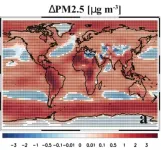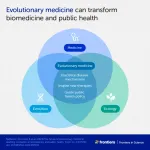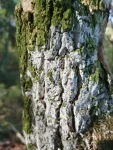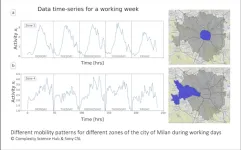(Press-News.org) COLUMBUS, Ohio – Using data from the James Webb Space Telescope’s first year of interstellar observation, an international team of researchers was able to serendipitously view an exploding supernova in a faraway spiral galaxy.
The study, published recently in The Astrophysical Journal Letters, provides new infrared measurements of one of the brightest galaxies in our cosmic neighborhood, NGC 1566, also known as the Spanish Dancer. Located about 40 million miles away from Earth, the galaxy’s extremely active center has led it to become especially popular with scientists aiming to learn more about how star-forming nebulae form and evolve.
In this case, scientists were able to survey a Type 1a supernova – the explosion of a carbon-oxygen white dwarf star, which Michael Tucker, a fellow at the Center for Cosmology and AstroParticle Physics at The Ohio State University and a co-author of the study, said researchers caught by mere chance while studying NGC 1566.
“White dwarf explosions are important to the field of cosmology, as astronomers often use them as indicators of distance,” said Tucker. “They also produce a huge chunk of the iron group elements in the universe, such as iron, cobalt and nickel.”
The research was made possible thanks to the PHANGS-JWST Survey, which, due to its vast inventory of star cluster measurements, was used to create a reference dataset to study in nearby galaxies. By analyzing images taken of the supernova’s core, Tucker and co-author Ness Mayker Chen, a graduate student in astronomy at Ohio State who led the study, aimed to investigate how certain chemical elements are emitted into the surrounding cosmos after an explosion.
For instance, light elements like hydrogen and helium were formed during the big bang, but heavier elements can be created only through the thermonuclear reactions that happen inside supernovas. Understanding how these stellar reactions affect the distribution of iron elements around the cosmos could give researchers deeper insight into the chemical formation of the universe, said Tucker.
“As a supernova explodes, it expands, and as it does so, we can essentially see different layers of the ejecta, which allows us to probe the nebula’s core,” he said. Powered by a process called radioactive decay – wherein an unstable atom releases energy to become more stable – supernovas emit radioactive high-energy photons like uranium-238. In this instance, the study specifically focused on how the isotope cobalt-56 decays into iron-56.
Using data from JWST’s near-infrared and mid-infrared camera instruments to investigate the evolution of these emissions, researchers found that more than 200 days after the initial event, supernova ejecta was still visible at infrared wavelengths that would have been impossible to image from the ground.
“This is one of those studies where if our results weren’t what we expected, it would have been really concerning,” he said. “We’ve always made the assumption that energy doesn’t escape the ejecta, but until JWST, it was only a theory.”
For many years, it was unclear whether fast-moving particles produced when cobalt-56 decays into iron-56 seeped into the surrounding environment, or were held back by the magnetic fields supernovas create.
Yet by providing new insight into the cooling properties of supernova ejecta, the study confirms that in most circumstances, ejecta doesn’t escape the confines of the explosion. This reaffirms many of the assumptions scientists have made in the past about how these complex entities work, Tucker said.
“This study validates almost 20 years’ worth of science,” he said. “It doesn’t answer every question, but it does a good job of at least showing that our assumptions haven’t been catastrophically wrong.”
Future JWST observations will continue to help scientists develop their theories about star formation and evolution, but Tucker said that further access to other types of imaging filters could help test them as well, creating more opportunities to understand wonders far beyond the edges of our own galaxy.
“The power of JWST is really unparalleled,” said Tucker. “It’s really promising that we’re accomplishing this kind of science and with JWST, there’s a good chance we’ll not only be able to do the same for different kinds of supernovas, but do it even better.”
This work was supported by the National Science Foundation, the Natural Sciences and Engineering Research Council of Canada, and others.
#
Contact: Michael Tucker, Tucker.957@osu.edu
Written by: Tatyana Woodall, Woodall.52@osu.ed
END
Galactic explosion offers astrophysicists new insight into the cosmos
Study reveals new details about the universe’s chemical formation
2023-02-28
ELSE PRESS RELEASES FROM THIS DATE:
Internet treatment program to prevent child sexual abuse launched in several languages
2023-02-28
Following a successful pilot study, an online anonymous treatment program aimed at reducing child sexual abuse by providing treatment to individuals who exhibit sexual urges towards children is being launched across the EU. It is now available in Swedish, German, and Portuguese as well as in an updated English version. The treatment program, which has been developed by researchers and psychologists at Karolinska Institutet in Sweden, will be evaluated within the framework of an international research collaboration funded by the EU.
"Sexual exploitation of children is a major problem within ...
Liquid nitrogen spray could clean up stubborn moon dust
2023-02-28
PULLMAN, Wash – A liquid nitrogen spray developed by Washington State University researchers can remove almost all of the simulated moon dust from a space suit, potentially solving what is a significant challenge for future moon-landing astronauts.
The sprayer removed more than 98% of moon dust simulant in a vacuum environment with minimal damage to spacesuits, performing better than any techniques that have been investigated previously. The researchers report on their work in the journal, Acta Astronautica.
While people have managed ...
Annals HRSA Special Supplement February 2023 Media Tip Sheet
2023-02-28
LEAWOOD, Kansas—Articles appearing in an Annals of Family Medicine special supplement published yesterday contain observations, insights, and ideas for advancing health care equity, promoting interprofessional collaboration, transforming education, and improving primary care practices.
The supplement, titled, “Advancing Primary Care through Research, Education and Practice: Work of the Health Resources and Services Administration–Supported Academic Units for Primary Care Training and Enhancement,” highlights activities of six HRSA-funded academic units for primary care training enhancement. ...
Breathing is going to get tougher
2023-02-28
Not all pollution comes from people. When global temperatures increase by 4 degrees Celsius, harmful plant emissions and dust will also increase by as much as 14 percent, according to new UC Riverside research.
The research does not account for a simultaneous increase in human-made sources of air pollution, which has already been predicted by other studies.
“We are not looking at human emissions of air pollution, because we can change what we emit,” said James Gomez, UCR doctoral student and lead author of the study. “We can ...
Scientists unveil plan to create biocomputers powered by human brain cells
2023-02-28
Artificial intelligence (AI) has long been inspired by the human brain. This approach proved highly successful: AI boasts impressive achievements – from diagnosing medical conditions to composing poetry. Still, the original model continues to outperform machines in many ways. This is why, for example, we can ‘prove our humanity’ with trivial image tests online. What if instead of trying to make AI more brain-like, we went straight to the source?
Scientists across multiple disciplines ...
From anti-antibiotics to extinction therapy: how evolutionary thinking can transform medicine
2023-02-28
The word ‘evolution’ may bring to mind dusty dinosaur bones, but it impacts our health every day. For example, even though antibiotics were invented only a century ago, the evolution of antibiotic resistance is already a major concern. The rise in modern health problems such as obesity can also be traced back to evolutionary principles.
An article published in Frontiers in Science demonstrates how applying an evolutionary perspective to medicine can inspire new ways of preventing and treating disease.
“Evolutionary medicine holds promise to transform our understanding of why we get sick ...
Researchers from the Institute of Botany discovered a new type of coexistence between algae and fungi
2023-02-28
Researchers from the Institute of Botany, Czech Academy of Sciences, described the symbiotic relationship between fungi and algae which science has largely overlooked until now. The coexistence of algae and corticioid basidiomycetes, which are common in temperate forests, has been given a new name: alcobiosis.
Jan Vondrák of the Department of Taxonomy, Institute of Botany, and the first author of the study says “Years ago, during field trips, we were repeatedly puzzled to find a layer of green algae where some of the fungal coatings on wood or bark (so-called corticioid fungi) are disturbed. We discovered that this is a ...
The largest genomic study of rare cancer metastathic pheochromocytoma identifies patients at highest risk of metastasis and those who would respond to immunotherapy
2023-02-28
The new results will help to follow patients with a bad prognosis more closely, and to move towards more personalized treatments.
Mercedes Robledo, co-lead author, has been studying pheochromocytomas since 1996 and leads the CNIO group that has identified 5 of the 22 genes associated with these rare tumors.
The research analyzes an "exceptionally high" number of samples, something very difficult in rare diseases and achieved thanks to the collaboration of centers from countries all over the world.
Pheochromocytoma is a rare tumor, with an ...
How to predict city traffic
2023-02-28
A new machine learning model can predict traffic activity in different zones of cities. To do so, a Complexity Science Hub researcher used data from a main car-sharing company in Italy as a proxy for overall city traffic. Understanding how different urban zones interact can help avoid traffic jams, for example, and enable targeted responses of policy makers - such as local expansion of public transportation.
Understanding people's mobility patterns will be central to improving urban traffic flow. “As populations grow in urban areas, this knowledge can help policymakers design and implement effective transportation ...
Parental support for LGBTQ youth is important, research shows
2023-02-28
Depression is more widespread among lesbian, gay, bisexual, transgender, or questioning (LGBTQ) youth than heterosexual, cisgender youth, making parental support more important for these adolescents. A new study released in Child Development by researchers at The University of Texas at Austin looks at parental social support and psychological control in relation to depressive symptoms for LGBTQ youth in the United States. Psychological control attempts to intrude into the psychological and emotional development of the child (e.g., thinking processes, self-expression, emotions, and attachment to parents). Although ...
LAST 30 PRESS RELEASES:
Flour choice shapes sourdough microbial communities
Can a retinal implant reverse macular degeneration?
Feeding fungi plant remnants produces tasty protein to fortify vegan, vegetarian diets
New tech reduces false positives from breast ultrasounds
Drone-mounted lab monitors fertilizer runoff in real time
Short, light-intensity exercise boosts executive function and elevates mood in children
Jeonbuk National University researchers reveal new interface engineering strategy for efficient and stable back-contact solar cells
Tyrosinase drives hydroquinone-induced exogenous ochronosis: not HGD inhibition
UMass Amherst chemists develop unique tool for studying RNA
Disappointment alters brain chemistry and behavior
A built-in odometer: new study reveals how the brain measures distance
Stress-related brain signals drive risk of cardiovascular disease in people with depression and anxiety
New details on role of fat transport molecules in Alzheimer’s onset
Study illuminates how an antiviral defense mechanism may lead to Alzheimer’s disease
Spot the males: New gene-editing method could transform mosquito control
AI learns to build simple equations for complex systems
NAU team releases 13 years of detailed U.S. CO2 emissions data
Unveiling how sodium-ion batteries can charge faster than lithium-ion ones
How do childcare tax credits affect children’s long-term health?
Can an electronic nose detect indoor mold?
Do natural disasters have long-term impacts on mortality in older adults?
Modification improves sodium‐ion batteries as an alternative to lithium-ion batteries
Parasports provide a range of benefits for people with cerebral palsy
How does grandparental care affect children’s health?
Why are there so many Nordic mediators?
Young shark species more vulnerable to extinction
Mobile fetal heart monitoring linked to fewer newborn deaths in Tanzania
Bluey’s dad offered professorial chair in archaeology at Griffith University
Beyond small data limitations: Transfer learning-enabled framework for predicting mechanical properties of aluminum matrix composites
Unveiling non-thermal catalytic origin of direct current-promoted catalysis for energy-efficient transformation of greenhouse gases to valuable chemicals
[Press-News.org] Galactic explosion offers astrophysicists new insight into the cosmosStudy reveals new details about the universe’s chemical formation






